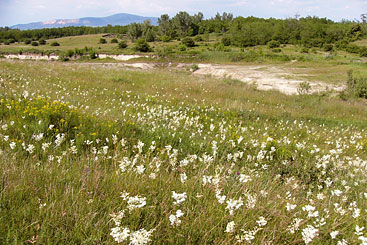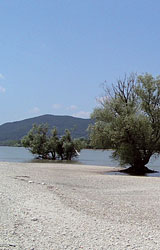
Danube-Ipoly National Park celebrates ten years
One of the most important Hungarian national parks, the beautiful Danube-Ipoly National Park, north of Budapest, continues to shine as one of the treasures of the Danube River Basin.

The sand dunes and sandy grasslands of the island are home to Colchicum arenarium and Joint Pine.
The national park of the Danube bend is perhaps the most diverse among all ten hungarian national parks. Its mission is to protect forested hills as well as riparian and lowland habitats. In addition to national protection and the biosphere Reserve designation, most of the area has become part of the NaTuRa 2000 network in recent years, while the Ipoly valley has been designated a transboundary Ramsar site with Slovakia.
Jubilee and foresight. On October 12, 2007, the Danube- Ipoly National Park invited national representatives and international guests to celebrate the tenth anniversary of this protected area. Official representatives from Hungary, such as State Secretary László Haraszthy, paid tribute to the administration of the National Park for their work in the past ten years. National Park Director András Füri thanked partners and colleagues for the strong cooperation as the basis of the effective development of Danube-Ipoly National Park. The grand opening of the presentation ‘LIVING DANUBE – protected areas along the Danube from the Black Forest to the Black Sea’ led to a transnational programme in the afternoon.
A second workshop for the establishment of the ‘Danube River Network of Protected Areas’ took place under the patronage of the Danube-Ipoly National Park, following the Declaration of Tulcea (see Danube Watch 2/2007). The interim speaker of the ‘Danube River Network of Protected Areas’ and Director of the Danube Flood Plain National Park Carl Manzano summarised the steps realised in the last months. All participants of the workshop – representing 13 protected areas of eight different countries at the Danube River – declared their interest and support for the development of a transnational project for the establishment of the Danube River Network of Protected Areas.
THE DANUBE-IPOLY NATIONAL PARK
| Date of foundation: | 28 November 1997 |
| Area: | 60,314 hectares |
| Rivers: | Danube, Ipoly |
| Most important peaks: | Csóványos (938 m), Nagy-Hideg Hill (864 m), Pilis Peak (756 m), Dobogó-kó´ (699 m) |
| Number of listed caves: 334 | |
| Areas of high importance: |
Pilis Biosphere Reserve
Ipoly Valley Ramsar site Pilis Hillside Forest Reserve Preacher’s Podium Forest Reserve Pogány-Rózsási Forest Reserve |
| Visitor centres: | Esztergom Interpretation Centre Királyrét Open-air School |
| Nature trails: | Path of Pages nature trail (Drégelypalánk) Páskom Grassland nature trail (Dejtár) Strázsa Hill nature trail (Esztergom) |
| Website: | www.dinpi.hu |
 The flora of the
Danube-Ipoly National
Park is a transition, a
virtual meeting area
of the plants of the
Transdanubian Mountains
and the North Hungarian
Mountains.
The flora of the
Danube-Ipoly National
Park is a transition, a
virtual meeting area
of the plants of the
Transdanubian Mountains
and the North Hungarian
Mountains.Foundation of the Danube-Ipoly National Park. Establishing the national park was quite extraordinary. In the late 1980s and early 1990s, major dam constructions on the Danube River had already been well under way in the former Czechoslovakia and in Hungary. Recognising that these constructions would lead to serious ecological and economic consequences, the Hungarian Parliament decided in April 1991 to stop the works in the Danube Bend and undertake necessary environmental restoration. Parliament also approved a resolution on the environmental tasks concerning the Danube, which included the establishment of the Danube-Ipoly National Park to safeguard the region’s natural ecosystems and regenerate natural resources. After several years of thorough technical preparation, the national park was established on 60,134 ha on 28 November 1997.
Teaching conservation. School children regularly visit the Királyrét Open-air School and the Esztergom Interpretation Centre, as well as three nature trails. Thanks to the support of the EU INTERREG fund, Slovak–Hungarian bilingual information boards and publications provide information on the national park. Since the Danube Bend is a prominent tourist attraction, the ten rangers working within the national park are kept busy. They have organised several successful actions aiming to eliminate illegal motocross riding, one of the biggest problems in recent years.
Natural values. The landscape formed by the millennial wrestling between the Danube and the mountains offers a splendid view. On its way to the Hungarian Plain, the giant river is here forced between steep hillsides, causing it to take a sharp U-turn around the andesite block of Szent Mihály Hill. On the right side of the Danube, the castle hill of Visegrád is crowned by a medieval fortress. On the left, the panorama from the 800–900-metre-high peaks of the Börzsöny Mountains over untouched forests is truly magnificent
The flora of the Danube-Ipoly National Park is a transition, a virtual meeting area of the plants of the Transdanubian Mountains and the North Hungarian Mountains. Along with other species, the Hellebore (Helleborus purpurascens) has a north-easterly range and does not occur further southwest from the Pilis, whereas Odorous Garlic (Allium suaveolens) – and numerous similar species – cannot be found to the east of this area. Several valuable survivals of the Hungarian autochthon flora live here, such as Pannon Ferule (Ferula sadleriana).
 The banks of open sand
pits provide nesting places
to protected Bee-eaters
and Sand Martins.
The banks of open sand
pits provide nesting places
to protected Bee-eaters
and Sand Martins.Pilis Mountain. In many places, the limestone and dolomite bedrock of the mountain outcrops on steep hillsides. Most of the nearly 200 caves within the national park are found in the Pilis. They are renowned for their archeological values (e.g. Paleolithic hunting tools and reindeer bones), thermal formations and some are also important bat roosts. Rock grasslands on rocky hillsides hold some perfectly camouflaged grasshopper species, such as Saga pedo and Acrida hungarica, as well as the tiny Snake-eyed Skink. The most remarkable features of cultural heritage are the Pauline cloister ruins at Klastrompuszta and the diversity of ethnic traditions maintained by varied minorities such as Swabians, Slovaks and Jassics.
Börzsöny Mountain. North of the Danube Bend, the volcanic Börzsöny Mountains are still preserved in relatively untouched conditions. This statement is attested by the richness of fauna. Black Storks nest in eight areas and these forests are a major stronghold of the White-backed Woodpecker in Hungary. In November 2007, park ranger László Darányi first photographed Lynx in the Börzsöny.
Ipoly River. The short unregulated stretch of the Ipoly between Hont and Ipolyvece is considered a rarity in Hungary, because its primordial conditions have not been significantly altered by man. Perhaps the most impressive scenery is found in alder bog woods. Flooded for most of the year, the trunks of old alders thicken towards the roots to provide support on the water-logged soil. The vernacular Hungarian term for these trees translates as ‘legged alder’. The Ipoly Valley has also been designated under the Ramsar Convention as a wetland of international importance.
The szentendrei Island and the Danube. The sand dunes and sandy grasslands of the island are home to Colchicum arenarium and Joint Pine. The banks of open sand pits provide nesting places to protected Bee-eaters and Sand Martins. The Danube and its flood plain harbour nearly 50 mollusc species. A typical snail species of the fast-flowing stretch in the Danube Bend is Theodoxus danubialis. The strong currents of the main branch are preferred by fish species such as Zingel, Danube Streber and Schraetzer. The Danube was once the boundary, known in Latin as ‘limes’, of the Roman Empire, which is commemorated by numerous ruins of watchtowers.
Disclaimer
The information contained in the ICPDR website is intended to enhance public access to information about the ICPDR and the Danube River. The information is correct to the best of the knowledge of the ICPDR Secretariat. If errors are brought to our attention we will try to correct them.
The ICPDR, expert group members, nor other parties involved in preparation of information contained on this website cannot, however, be held responsible for the correctness and validity of the data and information provided, nor accept responsibility or liability for damages or losses arising directly or indirectly from the use of the information conveyed therein.
Only those documents clearly marked ICPDR documents reflect the position of the ICPDR.
Any links to other websites are provided for your convenience only. The ICPDR does not accept any responsibility for the accuracy, availability, or appropriateness to the user's purposes, of any information or services on any other website.
When using the information and material provided on this website, credit should be given to the ICPDR.
